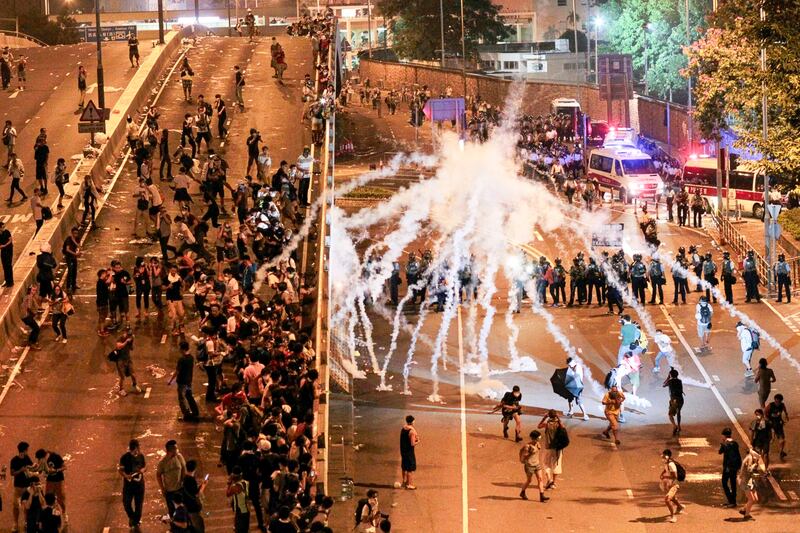Ten years ago, as the streets of Hong Kong pulsed with pro-democracy demonstrations, riot police repeatedly fired pepper spray and tear gas at the crowds that sometimes swelled to more than 100,000.
To protect themselves, protesters held up umbrellas – which became an iconic image of the protests that went viral in local and international media. Yellow became the protest umbrella color for its contrast against the dark clothing of many demonstrators, and the protests became known as the " Umbrella Movement."
It was the largest show of civil disobedience since control of the former British colony was handed over to China in 1997. Tens of thousands of people, many of them students, camped in the streets and for 11 weeks occupied much of the business district of the city of 7 million people.
What sparked the protests?
The protesters’ main demand was the right to elect the chief executive of Hong Kong, which was promised in the Basic Law, the constitution for post-handover Hong Kong as a “special autonomous region” of China under the "one country, two systems” formula that gave the city some autonomy and the right to retain its system for 50 years.
Small protests over the lack of movement on candidate selection had been increasing when, on Aug. 31, 2014, China’s parliament decreed that elections in Hong Kong in 2017 would be permitted -- from a list of candidates pre-approved by Beijing and nominated by a body of business elites and pro-Beijing groups.

The ruling sent people out into the streets banging pots and pans and chanting, and prompted waves of university campus strikes and protests.
Pro-democracy leaders formed plans for a civil disobedience campaign against the decision, releasing a manifesto called “Occupy Central with Love and Peace” and calling for the takeover of streets outside the city’s financial district on Oct. 1, China’s national day.
A fast-moving series of campus protests and actions by student groups to take over city streets led “Occupy Central” to be moved up several days.
People built a protest city of tents and stages that rang out with protest songs while students did homework in camps. Activists and ordinary citizens demonstrated outside government headquarters and occupied city intersections and thoroughfares.
How did umbrellas get involved?
Hong Kong authorities declared the protests illegal and a “violation of the rule of law,” and tensions began to mount.
On the night of Sept. 26 and into the next day, riot police clashed with protesters on the streets, firing pepper spray at them and arresting some. Over subsequent days, protesters began using umbrellas to protect themselves.
"The image is a poignant one, and emphasizes the asymmetry of force: an innocuous household object held up against helmeted police officers wielding poisonous substances for crowd control," the U.S. publication Quartz wrote.

The first known appearance of the term "umbrella revolution" was in the hashtag #UmbrellaRevolution generated by a news aggregator and circulated with a Sept. 28, 2014, report on the protests in the online edition of the British daily, The Independent.
Use of the hashtag along with eye-catching umbrella photographs spread among Hong Kong journalists and activists. The outpouring of umbrella memes included clever Cantonese puns and word play – and even a meme featuring Chinese paramount leader Xi Jinping holding a yellow umbrella.
Was the Umbrella Movement an example of a “revolution?”
Despite the worldwide sympathy for Hong Kong protesters, campaign leaders were quick to disavow the term “revolution.”
They flatly rejected comparisons to the color revolutions that had seen authoritarian governments in former Soviet republics and elsewhere overthrown, stressing their focus on practical reforms.
"We are not seeking revolution. We just want democracy!" Joshua Wong, a leading figure of the student movement, was quoted by The Washington Post.
"This is not a color revolution," Lester Shum, the deputy leader of the Hong Kong Federation of Students, told the Post.

Protest leaders warned that talk of revolution would alienate the broader Hong Kong public and give ammunition to Chinese Communist Party leaders who viewed the protests as rebellion and wanted to crush them.
The mainstream Occupy Central campaign agreed on “Umbrella Movement,” but some groups that advocated more aggressive tactics continued to use “Umbrella Revolution.”
The occupation and protests that began on Sept. 26 lasted in pockets of Hong Kong for 79 days, until Dec. 15.
They did not achieve their goal of universal suffrage and Wong, Shum and many protest leaders are in jail, while others have gone into exile to avoid arrest under draconian security and sedition laws.
